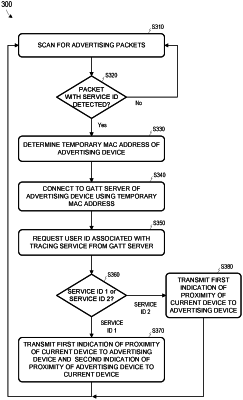| CPC H04W 76/11 (2018.02) [H04W 4/029 (2018.02); H04W 4/80 (2018.02)] | 18 Claims |

|
1. A system comprising:
a first device comprising:
a memory storing processor-executable program code;
a processing unit to execute the processor-executable program code to cause the first device to:
receive a wireless communication packet from a second device;
determine a received service identifier included in the wireless communication packet;
determine whether the received service identifier matches a first service identifier or a second service identifier;
if the received service identifier matches the first service identifier or the second service identifier, establish a connection to a server of the second device using a device address included in the wireless communication packet;
request, using the connection, a user identifier from the server of the second device;
if the received service identifier matches the first service identifier, transmit, to a remote server, a first indication of proximity of a user of the first device to a user associated with the user identifier and a second indication of proximity of the user associated with the user identifier to the user of the first device; and
if the received service identifier matches the second service identifier, transmit, to the remote server, the first indication of proximity of the user of the first device to a user associated with the user identifier and do not transmit, to the remote server, the second indication of proximity of the user associated with the user identifier to the user of the first device.
|